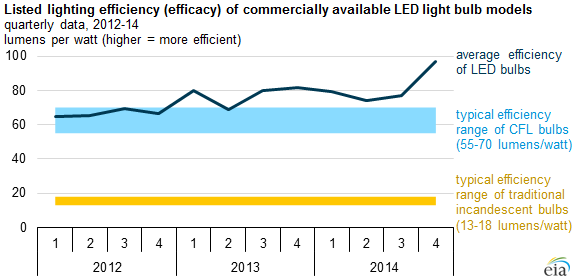 |
|
Note: Reflects Lighting Facts database through November 3, 2014 .(Source: EIA, based on Department of Energy's Lighting Facts Database) |
Improvements in lighting technology for light-emitting diode (LED) bulbs have increased lighting efficiency, or efficacy, as well as color quality. In September of this year, several manufacturers released ENERGY STAR®-qualified bulbs surpassing 100 lumens per watt. For comparison, traditional incandescent bulbs, which do not meet current light bulb efficiency standards and are no longer sold, provide 13 to 18 lumens per watt.
When first introduced, LED bulbs were far more expensive than other bulbs, but their costs have since come down dramatically. Even now, however, they are often the most expensive bulbs on the shelf, but their much longer lifetimes and lower power draw can economically justify the higher initial cost
Costs to consumers have also been reduced by dozens of energy-efficiency programs that offer in-store or mail-in rebates, discounts, or other incentives. The ENERGY STAR program estimates that from 2011 through 2013, energy efficiency program sponsors spent $400 to $470 million annually to encourage the adoption of ENERGY STAR-qualified lighting products. These products include certain LEDs, compact fluorescent lamps (CFLs), ceiling fan light kits, and other luminaires. More information about these state, local, and utility programs can be found at ENERGY STAR's rebate finder website and at the Database of State Incentives for Renewables and Efficiency.
Shipment data collected by ENERGY STAR show that LED bulb shipments have increased from about 9 million bulbs in 2011 to more than 45 million bulbs in 2013, reaching an estimated 2.3% market share of general service lighting. Shipments of CFLs have been about 300 million annually since 2011, with an estimated market share of 15% to 20%.
The Department of Energy's (DOE) Solid-State Lighting Program has encouraged research and development of solid-state lighting, primarily LEDs, and promoted consumer education as the market evolves. The Lighting Facts label that appears on almost all light bulb packages provides information on the brightness (in lumens), power draw (in watts), efficacy (lumens per watt), assumed lifetime, and estimated annual energy costs.
Two quality characteristics that often appear on these labels are the bulb's color temperature and color rendering index (CRI) values.
· Color temperature, measured in kelvins (K), refers to the appearance of the light from warm tones to cool tones. Lamps with lower color temperatures (around 2,500 K to 3,500 K) are closer to traditional incandescent and halogen bulbs, with slightly orange tones. Sunlight and some fluorescent lamps are associated with higher, bluer color temperatures. The ENERGY STAR specification requires color temperature to be between 2,750 K and 6,500 K.
· Color rendering index measures how well the light renders or depicts the colors of objects, materials, and skin tones. For bulbs with color temperatures below 5,000 K, the index considers an incandescent lamp as essentially 100, so the more the appearance of a color sample deviates from its appearance under incandescent light, the lower its CRI will be. The ENERGY STAR specification requires CRI values to be at least 80, and several manufacturers have been able to meet this specification. However, consumer preference studies have found low correlation between consumer rankings and CRI values, so low CRI values may not indicate poor light quality.













